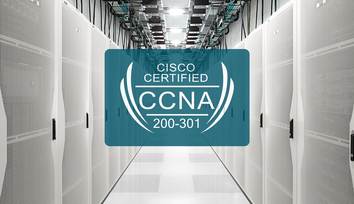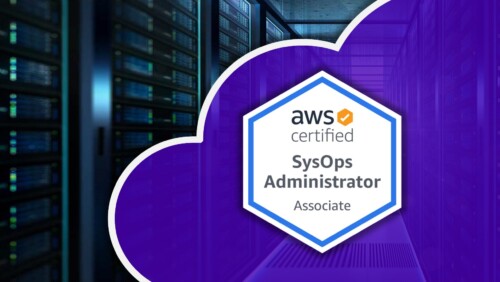Description
Overview
This course will teach students about information systems risk. Topics covered include risk identification, assessment, evaluation, response, and monitoring, as well as information systems control design and implementation.
Series Taught By: John Glover
Available CEUs for Course Series Completion: 6
Students can earn up to 6 CEUs for fully completing this course series. This information will be displayed on the certificate of completion. Learn More
- 30:34:00 Hours
- 12 Months Access
- Presented by highly qualified, industry leading experts
The CCNA certification is for entry level employees. The Cisco Certified Network Associate (CCNA) programme prepares you for a variety of IT vocations by providing you with a broad range of essential knowledge. You’ll even have the opportunity to create simple local area networks (LANs). You’ll be able to do basic setups for routers and switches after developing a working grasp of IP addressing systems and core network security. The CCNA is an entry-level networking certification that can help you get a job as a network expert, network administrator, or network engineer in the IT industry.
Your ability to install, configure, operate, and troubleshoot routed and switched networks are validated by the CCNA certification. It provides thorough associate-level training and certification in the solutions and technologies you’ll need to install and manage a wide range of modern networking and IT infrastructure. CCNA certified professionals can use a wide area network (WAN) to connect to remote locations, mitigate basic network security risks, and grasp basic networking principles and terminology.
Becoming a CCNA certified network administrator or engineer is a significant first step toward a fulfilling career as a network administrator or engineer.
- Learn how to set up, configure, and manage a small to medium-sized network.
- Understand the fundamentals of networking, security, and automation.
Audience
This course is for anyone who wants to get their CCNA certification. All support technicians involved in the fundamental installation, operation, and verification of Cisco networks would benefit from this training.
The job roles best suited to the material in this course are:
- Entry-level network engineer
- Network administrator
- Network support technician
Help desk technician
Prerequisites
Before taking this course, you should have:
- One or more years of experience implementing and administering Cisco solutions
- Knowledge of basic IP addressing
- A good understanding of network fundamentals
- Basic PC operating system navigation skills
Basic Internet usage skills
Course Outline
Top of Form
NETWORKING FUNDAMENTALS
- Overview
- Networking Components: Overview
- Networking Components: Routers And Switches
- Networking Components: NGFW And NGIPS
- Networking Components: Cisco DNA Center
- Networking Components: WLCs And Access Points
- Networking Components: Servers And Endpoints
- Networking Topology Architectures: Overview
- Network Topology Architectures: Data Center
- Networking Topology Architectures: WAN
- Networking Topology Architecture: Cloud
- Networking Topology Architectures: SOHO
- Layer 1: Interfaces And Cabling
- Layer 1: Interfaces And Cabling Part 2
- Identifying Layer 1 Issues
- Identifying Layer 1 Issues Part 2
- Networking Protocols
- Networking Protocols Part 2
- IP Addressing: Overview
- IP Addressing: IPv4 Basics
- IP Addressing: IPv4 Subnetting Class C
- IP Address: IPv4 Subnetting Class B
- IP Addressing: IPv4 Subnetting Class A
- IP Addressing: VLSM
- IP Addressing: IPv6 Basics And Address Types
- IP Addressing: IPv6 Basics And Address Types Pt.2
- IP Addressing: IPv6 Configuration
- IP Addressing: Client OS
- Virtualization Fundamentals
- Virtualization Fundamentals Part 2
NETWORK ACCESS
- Network Access Overview
- Cisco Switching: Basic Concepts
- Cisco Switching: VLAN Configurations
- Cisco Switch: VLAN Configurations Part 2
- Cisco Switching: Interswitch Connectivity
- Cisco Switching: Interswitch Connectivity Part 2
- Cisco Switching: L2 Discovery Protocols
- Cisco Switching: L2 Discovery Protocols Part 2
- Cisco Switching: L2 Etherchannel Configuration
- Cisco Switching: L2 Etherchannel Config Pt.2
- Cisco Switching: L3 Etherchannel Configuration
- Cisco Switching: Spanning Tree Protocol Basics
- Cisco Switching: STP Operations
- Cisco Switching: STP Configuring RPVSTplus
- Cisco Switching: STP Portfast And BPDUguard
- Cisco Wireless Basics
- Cisco Wireless Architecture
- Cisco WLAN Components
- Cisco WLC Configuration
- Cisco Wireless Management Access
IP CONNECTIVITY
- IP Connectivity: Overview
- IP Connectivity: Routing Basics
- IP Addressing: IPv4 Configuration
- IP Addressing: IPv4 Subnetting Review
- IP Connectivity: IPv4 Static Default, Net Routes
- IP Connectivity: IPv4 Static Host, Floating Routes
- IP Connectivity: IPv6 Static Default, Net Routes
- IP Connectivity: IPv6 Static Host, Floating Routes
- IP Connectivity: Dynamic Routing Basics
- IP Connectivity: Single Area OSPFv2
- IP Connectivity: Single Area OSPFv2 Part 2
- IP Connectivity: First Hop Redundancy Protocols
- IP Connectivity: First Hop Redundancy Proto Pt2
IP SERVICES
- IP Services Overview
- IP Services: Configuring, Verifying NAT
- IP Services: Configuring, Verifying NAT Pt.2
- IP Services: Configuring NTP
- IP Services: DNS And DHCP
- IP Services: DNS And DHCP Part 2
- IP Services: Configuring SNMP
- IP Services: Understanding Syslog
- IP Services: Understanding PHB For QoS
- IP Services: Configuring SSH
- IP Services: Using FTP And TFTP
SECURITY FUNDAMENTALS
- Security Fundamentals Overview
- Key Security Concepts
- Security Program Components
- Security Password Policy Components
- Intro To AAA Security
- Understanding VPN Types
- Configuring And Verifying Standard ACLs
- Configuring And Verifying Extended ACLs
- Configuring And Verifying Named ACLs
- Configuring Port Security-Static
- Configuring Port Security-Sticky
- Configuring DHCP Snooping And DAI
AUTOMATION AND PROGRAMMABILITY
- Automation and Programmability Overview
- Intro To Network Programmability
- Intro To SDN Architectures
- Intro To API Concepts
- Intro To REST-Based APIs
- Intro To Cisco DNA Center
- Intro To Config Management Utilities
Interpret JSON Encoded Data



